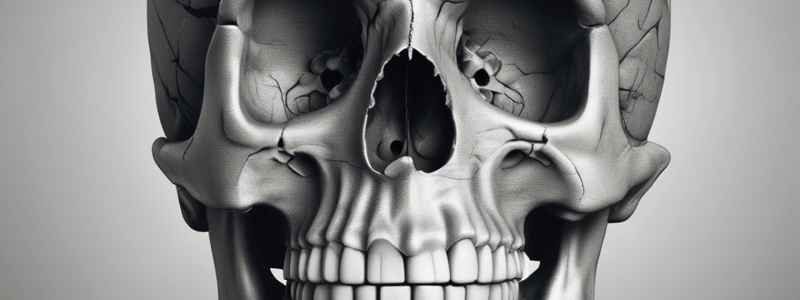Podcast
Questions and Answers
How many bones make up the skull?
How many bones make up the skull?
- 22 (correct)
- 12
- 26
- 18
Which is the only movable bone in the skull?
Which is the only movable bone in the skull?
- Frontal bone
- Mandible (correct)
- Maxilla
- Parietal bone
What is the primary function of the hyoid bone?
What is the primary function of the hyoid bone?
- Support the tongue (correct)
- Anchor the brain
- Protect the lungs
- Support the thoracic cavity
How many vertebrae are present in the vertebral column?
How many vertebrae are present in the vertebral column?
How many cervical vertebrae are there in the vertebral column?
How many cervical vertebrae are there in the vertebral column?
Which spinal deformity is characterized by a lateral bending of the vertebral column?
Which spinal deformity is characterized by a lateral bending of the vertebral column?
Where is the sternum located?
Where is the sternum located?
Which of these is a secondary curve of the vertebral column?
Which of these is a secondary curve of the vertebral column?
Flashcards are hidden until you start studying
Study Notes
The Skull
- Composed of 22 bones: cranial bones (cranium) and facial bones (face)
- Forms cranial cavity and smaller cavities (nasal and eye sockets)
- Certain bones contain mucous membrane-lined cavities called paranasal sinuses
- Mandible is the only movable bone in the skull, excluding ear ossicles
- Immovable joints called sutures hold skull bones together
General Functions of the Skull
- Protects and stabilizes the position of the brain, blood vessels, and nerves
- Site of attachment for muscles that move the head and generate facial expressions
- Supports the entrances to the digestive and respiratory systems and special sense organs
The Hyoid Bone
- Supports the tongue, providing attachment sites for tongue muscles and neck and pharynx muscles
- Helps keep the larynx (voice box) open at all times, examined in post-mortem for strangulation
Intervertebral Discs
- Absorb vertical shock between adjacent vertebrae
- Permit various movements of the vertebral column
- Made of a fibrocartilaginous ring with a pulpy center
The Vertebral Column
- Consists of 26 vertebrae
- Divided into 5 regions: 7 cervical, 12 thoracic, 5 lumbar, 1 sacrum, and 1 coccyx
Normal Curves of the Vertebral Column
- Primary curves: thoracic and sacral curves formed during fetal development
- Secondary curves: cervical curves form at 4 months old, lumbar curves form at 1 year old
Spinal Deformities
- Scoliosis: lateral bending of the vertebral column
- Kyphosis: exaggerated curve of the thoracic curve
- Lordosis: exaggerated curve of the lumbar curve
The Thorax
- Sternum: located in the center of the thoracic wall
- Ribs: 12 pairs provide structural support to the sides of the thoracic cavity
- Costal cartilages: contribute to the elasticity of the thoracic cage
Studying That Suits You
Use AI to generate personalized quizzes and flashcards to suit your learning preferences.




